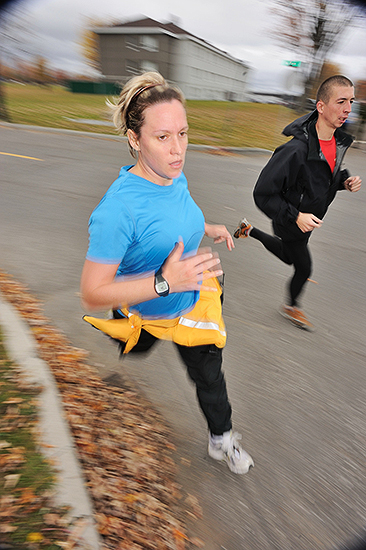Ask the Expert: Running Pain Free!
June 8, 2021 - Defence Stories

Caption
Running is a wonderful form of physical activity for your heart, muscles and bones.
Q: Over the winter, I kept myself physically active by cross-country skiing and maintaining a home strengthening exercise program. So far this Spring, I have been cycling but I also want to get back to running again. My goal is to be able to run 25 minutes, twice a week by the end of this summer. However, in the past, I have developed pain in my feet, right hip and knee when I run. Presently, I don’t have any joint pain and would like to keep it this way. Could you provide me some advice on a progressive running program that could help me achieve this goal and keep me pain free? Corporal Painfree
A: Dear Corporal Painfree: The investment you put into your winter and spring fitness provides an excellent base to support your running objective for this summer. Keeping your body free of pain while you train is also a great approach towards achieving and maintaining your fitness goals. Congratulations for this vision!
Numerous running strategies exist in guiding runners at all levels to successfully build their running abilities, while assisting them to stay injury or pain free. The Dutch Athletics Federation’s Dutch Start to Run Programs is a great example of assisting inactive individuals to achieve a running distance of 5 km in six weeks. This program had low dropout rates, no injuries, and participants maintained an average of 150 minutes of vigorous exercise per week months after they finished the program! Start to Run uses the following recognized running strategies:
- Resisting the temptation to progress too fast. This is the biggest and most common mistake made by many who start out and are motivated. Remember, it is ok not to have pain or feel tired after a running session. Your goal is to feel more energized after a run because that is a good sign you are allowing your body to adjust adequately to something new.
- Running on alternating days. This gives your legs, joints, bones and muscles 48 hours to rest and recover from the new stress running applies to them.
- Limiting your running session to 30 minutes.
- Limiting running sessions to two to three times per week. Running can place a lot of strain on your legs and back. Research shows that running more than three times per week automatically exposes an individual to a higher risk of injury. Participating in less “pounding” types of fitness activities in between your runs is encouraged. Consider strengthening exercises, walking without any added weight, bicycling or swimming for your non-running days.
- Taking 10 to 15 minutes to actively warm-up before your run (e.g., walk while gradually increasing your speed, do hopping exercises). This prepares your muscles, tendons and joints and reduces the chance of injury.
- Using “walk - run” sequences in each training session. Planning low intensity periods of walking between your run sequences offers small recovery periods for your muscles and joints. This training method is not only for beginners, it is also used by competitive runners.
- Gradually increasing your running time over a minimum of six weeks.
- Gradually incorporating more demanding intensity periods in your running session (e.g. running faster; going up and down a small hill) followed by short recovery periods. This is often referred to as high-intensity interval training (known as “HIIT”) and is particularly convenient to optimize fitness and performance progression within your 30 min training sessions.
Bottom line: Running is a wonderful form of physical activity for your heart, muscles and bones. Research confirms a well-balanced running program can also prevent osteoarthritis and osteoporosis, which is good news for your feet, knees and hips! However, if you begin experiencing pain that does not resolve with rest, you should consider seeking professional assistance from a physiotherapist or a health care provider to identify and treat the reason for the pain. By addressing this pain early on, you will increase your chance of being successful in maintaining and completing your running objectives. Overall, adopting the Dutch Start to Run Programs or another similar progressive program, should support you with your Running Pain Free!

Lucie Laferrière, physiotherapist, M.H.A
Lucie Laferrière is the injury prevention specialist at the Directorate Forces Health Protection and she works with scientific evidence to provide advice. As part of the Strengthening the Forces team, she works on injury prevention and promoting active living.
Strengthening the Forces is CAF/DND’s healthy lifestyles promotion program providing expert information, skills and tools for promoting and improving CAF members’ health and well-being.